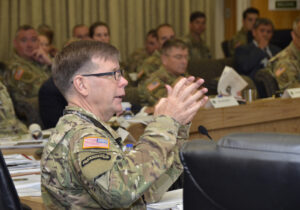By SYDNEY J. FREEDBERG JR.
The new HQ for Army Cyber Command, Fortitude Hall on Fort Gordon, Ga.
WASHINGTON: Army Cyber Command’s new $366 million headquarters at Fort Gordon, Ga. isn’t just a big building with a lot of computers in it. “This is a purpose-built weapons system,” Lt. Gen. Steve Fogarty, the ARCYBER commander, told reporters yesterday. “We are going to take a much more direct role in [cyber] attack.”
In 2018, the Trump White House gave the military much greater authority to infiltrate and attack foreign networks that threatened the US. But actually using that authority requires a highly-trained workforce – uniformed military, government civilian, and contractor – and a lot of technology.
Lt. Gen. Stephen Fogarty, chief of Army Cyber Command, addresses fellow senior officers.
“We probably have the best network in DoD right now,” Fogarty said. That’s because the new Fortitude Hall — named for the massive deception operation that convinced Hitler that the D-Day landings would occur in Calais, not Normandy – has more than 300 servers on site, over 3,000 miles of wiring, and high-speed connections to HQs around the world, both US and allied.
While Fogarty wouldn’t disclose which foreign nations are plugged in – that’s highly sensitive information, he said – we do know that Fortitude Hall connects to
the Georgia branch of the National Security Agency, also at Fort Gordon;
ARCYBER’s superior headquarters, US Cyber Command, whose HQ is collocated with NSA HQ at Fort Mead, Md.;
ARCYBER’s subordinate commands in the Army, including its Regional Cyber Centers in Arizona, Hawaii, Germany, Korea, and Kuwait; the former ARCYBER HQ, at Fort Belvoir, Md.; and the Network Enterprise Technology Command (NETCOM) at the Fort Huachuca, Ariz.
A layered approach comprised of NGI, Aegis BMD and THAAD could be available in the mid to late-2020s, which strengthens our defense against a rogue state missile attack.

From
That Huachuca connection is important because in recent years the Army has built up NETCOM’s authorities and capabilities to operate and defend US military networks, missions that historically took up much of ARCYBER HQ’s time and energy. Now that NETCOM has the lead on operate-and-defend, Fogarty said, ARCYBER proper can shift its focus to the “offense and influence portion of the mission.”
Now, “offense” is relatively straightforward. In layman’s terms, it means hacking into other countries’ networks.
But what is “influence?” That gets into Fogarty’s larger ambitions for Army Cyber Command, which he aims to rename Army Information Warfare Command. You see, historically, US cyber forces have focused on the technical aspects of hacking and defending computer networks. But adversaries are using cyberspace for much bigger strategic ends.
Russian trolls spread misinformation to subvert US elections. Chinese hackers steal trade secrets to boost their economy. ISIS propagandists post beheading videos on social media to terrify innocents and recruit fanatics. The US has fumbled most efforts to counter these forms of “information warfare” – and that’s something the Army wants to change.
Army Secretary Ryan McCarthy and Chief of Staff Gen. James McConville have both spoken approvingly of Fogarty’s plans. The formal name change for the command and the rescoping of its mission are still being thrashed out, the general said yesterday, “but we’re not waiting…We’re moving out.”
ARCYBER’s old headquarters at Fort Belvoir had an “Army Cyber Operations Integration Center,” where most of the data was tracking the health of Army networks, Fogarty said. But the heart of Fortitude Hall is a new Information Warfare Operations Center – the name choice is significant – that pulls in information, not just from military units, but from civilian sources worldwide. That should allow the Army to detect hostile propaganda and misinformation much more easily and react much more rapidly.
James McPherson
 The other big advantage of moving ARCYBER headquarters to Fort Gordon? Now they’re right next to the Army Cyber Center of Excellence, the “schoolhouse” where new cyber soldiers are trained and veteran operators return for advanced professional education. Putting everybody in one place allows for rapid sharing of new ideas, which is crucial in a field as fast-moving as cyber warfare. An ARCYBER operator can discover a new threat or develop a new technique, then walk over to the schoolhouse to teach it to a class; an advanced-course student can come up with new algorithms or insights, then walk over to an operational team and get them to try it out.
The other big advantage of moving ARCYBER headquarters to Fort Gordon? Now they’re right next to the Army Cyber Center of Excellence, the “schoolhouse” where new cyber soldiers are trained and veteran operators return for advanced professional education. Putting everybody in one place allows for rapid sharing of new ideas, which is crucial in a field as fast-moving as cyber warfare. An ARCYBER operator can discover a new threat or develop a new technique, then walk over to the schoolhouse to teach it to a class; an advanced-course student can come up with new algorithms or insights, then walk over to an operational team and get them to try it out.
“We’ve really consolidated all our cyberspace efforts [and] brought together our operators and our trainers and our policy developers in a way we don’t enjoy in any of the other domain areas,” said James McPherson, Army undersecretary, speaking alongside Fogarty after cutting the ribbon to formally open the new HQ. If operators discover something new, McPherson said approvingly, “they can pop that over to the training side within a day.”
“The more we operate, the faster we learn, the faster we’re able to operate on the next iteration,” Fogarty said. “The adversary’s moving much faster and we have to be faster than them.”


No comments:
Post a Comment